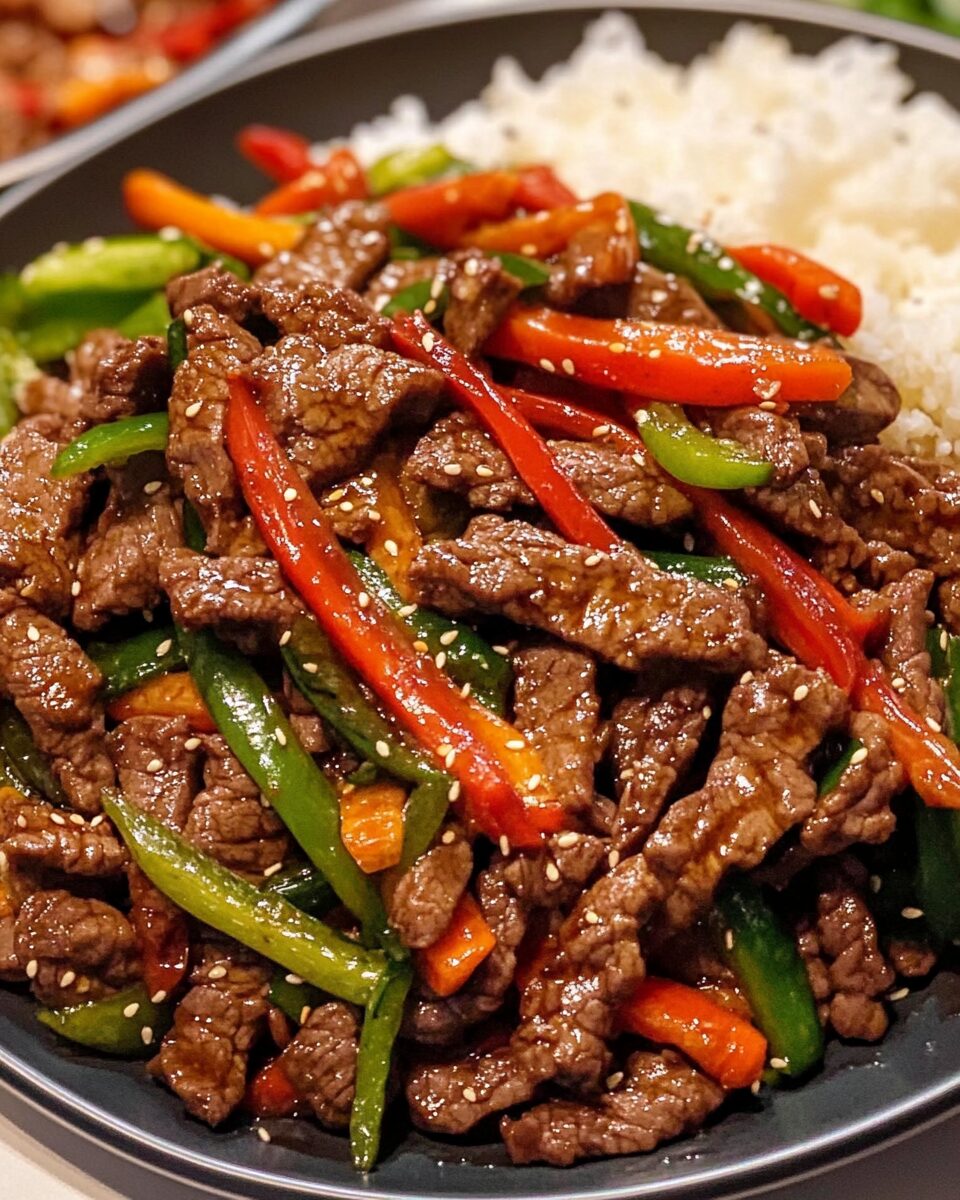The Mongolian Beef recipe is a delightful fusion of sweet and savory flavors, highlighted by a rich soy and garlic sauce. The tender slices of beef are perfectly coated, creating a dish that feels indulgent yet light enough for any weeknight dinner.
This recipe is incredibly versatile—you can pair it with steamed rice, quinoa, or even sautéed vegetables to make it a complete meal. Whether you’re cooking for family or impressing guests, this dish delivers restaurant-quality taste in the comfort of your home.
Full Recipe:
Ingredients:
- 1 lb (450 g) flank steak, thinly sliced
- 1/4 cup (60 ml) cornstarch
- 2 tbsp vegetable oil
- 3/4 cup (180 ml) low-sodium soy sauce
- 1/2 cup (120 ml) brown sugar
- 2 tsp fresh ginger, minced
- 4 cloves garlic, minced
- 1/4 cup (60 ml) water
- 1/4 tsp red pepper flakes (optional)
- 1/4 cup green onions, sliced
Directions:
- Lightly coat the sliced flank steak with cornstarch and set aside for 10 minutes.
- Heat the vegetable oil in a large skillet or wok over medium-high heat.
- Add the coated steak slices to the skillet in batches, ensuring not to overcrowd. Cook for 1-2 minutes per side until browned, then set aside.
- In the same skillet, reduce the heat to medium. Add soy sauce, brown sugar, ginger, garlic, and water. Stir and bring to a simmer.
- Let the sauce cook for 5 minutes until slightly thickened.
- Return the cooked steak to the skillet, tossing to coat in the sauce. Cook for another 2 minutes.
- Sprinkle with red pepper flakes, if using, and garnish with sliced green onions before serving.
Prep Time: 10 minutes | Cooking Time: 15 minutes | Total Time: 25 minutes
Kcal: 290 kcal | Servings: 4 servings
History and Origin of Mongolian Beef
Mongolian Beef is a popular dish in Chinese-American cuisine, known for its sweet and savory flavors. Despite its name, the dish doesn’t originate from Mongolia. Instead, it draws inspiration from the cooking techniques and flavors of Chinese cuisine, particularly the use of soy sauce, garlic, and ginger. The dish likely gained its “Mongolian” label due to creative marketing by restaurants aiming to evoke exotic flavors. Traditionally, this dish is stir-fried and served with rice, making it a favorite for quick, satisfying meals.
Key Ingredients and Substitutions
- Flank Steak: Known for its tenderness, flank steak is ideal for stir-frying. If unavailable, you can substitute it with skirt steak or sirloin. Slice the meat thinly across the grain for the best texture.
- Soy Sauce: This is the backbone of the dish’s flavor. Opt for low-sodium soy sauce to balance the saltiness, or try tamari for a gluten-free option.
- Brown Sugar: Adds the sweet counterpoint to the savory elements. Coconut sugar or honey can be used as natural alternatives.
- Garlic and Ginger: These aromatics provide depth and a fragrant kick. Freshly minced is ideal, but powders can be used in a pinch.
- Cornstarch: Coats the beef to give it a crispy exterior when cooked. Arrowroot powder or potato starch can serve as gluten-free alternatives.
- Green Onions: These provide a fresh garnish and a mild onion flavor. Chives or scallions can also work.
Tips for Cooking the Perfect Mongolian Beef
- Slice the Beef Thinly: To ensure quick cooking and tender bites, slice the beef as thinly as possible against the grain. A partially frozen steak is easier to cut.
- High Heat is Key: Stir-frying requires high heat to sear the beef quickly, locking in its juices. Avoid overcrowding the pan to maintain the right temperature.
- Thickening the Sauce: Simmer the sauce until it thickens slightly to coat the beef beautifully. If it becomes too thick, add a splash of water to loosen it.
- Customizing Heat Levels: If you prefer a spicier dish, increase the red pepper flakes or add chili oil to the sauce.
Pairing and Serving Suggestions
Mongolian Beef pairs wonderfully with:
- Steamed White or Jasmine Rice: The classic choice for soaking up the flavorful sauce.
- Brown Rice or Quinoa: For a healthier twist, these grains add fiber and nutrients.
- Stir-Fried Vegetables: Broccoli, bell peppers, or snap peas add color, crunch, and nutrition.
- Noodles: Serve the beef over rice noodles or lo mein for a comforting twist.
Variations to Try
- Vegetarian Mongolian “Beef”: Replace beef with tofu or seitan. For tofu, ensure it’s pressed and pan-fried to achieve a crispy texture.
- Chicken or Pork Mongolian Style: Substitute flank steak with thinly sliced chicken breast or pork tenderloin for a different protein experience.
- Low-Carb Option: Serve over cauliflower rice or spiralized zucchini for a keto-friendly version.
- Extra Veggies: Add carrots, mushrooms, or water chestnuts to make it a heartier meal.
Storage and Reheating Instructions
- Refrigeration: Store leftovers in an airtight container for up to 3 days.
- Freezing: Mongolian Beef can be frozen for up to 3 months. For best results, store the beef and sauce separately.
- Reheating: Warm the dish in a skillet over medium heat, adding a splash of water or broth to loosen the sauce as needed.
What Makes Mongolian Beef Special?
Mongolian Beef is a dish celebrated for its balance of flavors—sweet, savory, and slightly spicy. The star of the dish is tender beef coated in a glossy sauce made from soy sauce, brown sugar, garlic, and ginger. The simplicity of its ingredients and the quick cooking process make it a go-to recipe for weeknight dinners or casual gatherings.
The dish is perfect for those who enjoy the flavors of Chinese-American takeout but want a healthier, homemade version with full control over the ingredients. Its bold flavor profile and the succulent texture of the beef make it a standout among stir-fry dishes.
Cooking Methods and Techniques
- Stir-Frying: Mongolian Beef is traditionally prepared using the stir-frying method, which ensures that the beef cooks quickly and evenly, locking in its juices while achieving a slightly crispy exterior. A wok is ideal for this process, but a large skillet works well too.
- Marinating: Lightly coating the beef slices with cornstarch before cooking is a key step that not only helps to tenderize the meat but also gives the sauce something to cling to.
- Simmering the Sauce: Once the sauce ingredients are combined, simmering it allows the flavors to meld and the sauce to thicken, creating the signature glossy coating.
Nutrition and Health Benefits
Mongolian Beef can be adapted to suit different dietary needs:
- High Protein: The beef provides a significant source of protein, which is essential for muscle repair and overall health.
- Low-Calorie Option: By using leaner cuts of beef and reducing the amount of sugar, you can create a lighter version of this dish.
- Gluten-Free Alternative: Substitute tamari or coconut aminos for soy sauce and use arrowroot starch instead of cornstarch for a gluten-free version.
How to Make It Your Own
One of the best things about Mongolian Beef is its versatility. Here are some ideas for customizing the recipe:
- Add Vegetables: Include broccoli, bell peppers, snow peas, or carrots to increase the nutritional value and add texture.
- Make It Spicy: Amp up the heat by adding more red pepper flakes or a splash of sriracha.
- Use Different Proteins: Swap the beef for chicken, pork, or even shrimp to create a new twist on the classic recipe.
- Sweeten Naturally: Replace brown sugar with honey or maple syrup for a more natural sweetness.
Pairing Ideas for a Complete Meal
To complement the flavors of Mongolian Beef, consider serving it with:
- Rice: Steamed white rice, brown rice, or jasmine rice pairs perfectly to soak up the rich sauce.
- Noodles: Egg noodles or rice noodles create a satisfying alternative to rice.
- Side Dishes: Serve alongside steamed or stir-fried vegetables such as bok choy, asparagus, or green beans for a balanced plate.
Fun Facts About Mongolian Beef
- Mongolian Beef is often thought of as a Mongolian dish, but it’s actually a Chinese-American creation. Its name likely comes from the marketing appeal of “exotic” Mongolian flavors.
- This dish is particularly popular in Chinese takeout restaurants in the United States and has been adapted into various versions worldwide.
Reader Tips for Success
- Don’t Skip the Cornstarch: It creates a light coating on the beef that crisps up beautifully when cooked.
- Work Quickly: Stir-frying happens fast, so have all your ingredients prepped and ready to go before you start cooking.
- Control the Sauce Thickness: If the sauce is too thick, add a splash of water; if too thin, let it simmer a bit longer.
Conclusion
Mongolian Beef is a quick, flavorful dish that combines tender beef with a sweet-savory sauce. Perfect for weeknight dinners or special occasions, it’s versatile, easy to prepare, and pairs well with rice, noodles, or vegetables. This timeless classic brings the joy of cooking and sharing a delicious meal with loved ones.






